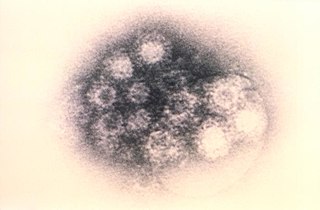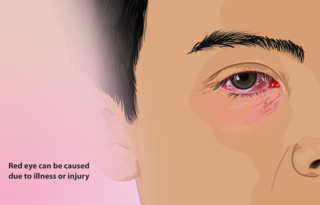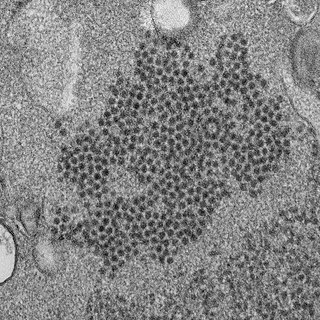
Coxsackie A virus (CAV) is a cytolytic Coxsackievirus of the Picornaviridae family, an enterovirus.

Conjunctivitis, also known as pink eye, is inflammation of the outermost layer of the white part of the eye and the inner surface of the eyelid. It makes the eye appear pink or reddish. Pain, burning, scratchiness, or itchiness may occur. The affected eye may have increased tears or be "stuck shut" in the morning. Swelling of the white part of the eye may also occur. Itching is more common in cases due to allergies. Conjunctivitis can affect one or both eyes.

The rhinovirus is the most common viral infectious agent in humans and is the predominant cause of the common cold. Rhinovirus infection proliferates in temperatures of 33–35 °C (91–95 °F), the temperatures found in the nose. Rhinoviruses belong to the genus Enterovirus in the family Picornaviridae.
Hand, foot, and mouth disease (HFMD) is a common infection caused by a group of enteroviruses. It typically begins with a fever and feeling generally unwell. This is followed a day or two later by flat discolored spots or bumps that may blister, on the hands, feet and mouth and occasionally buttocks and groin. Signs and symptoms normally appear 3–6 days after exposure to the virus. The rash generally resolves on its own in about a week. Fingernail and toenail loss may occur a few weeks later, but they will regrow with time.
Coxsackie B4 virus are enteroviruses that belong to the Picornaviridae family. These viruses can be found worldwide. They are positive-sense, single-stranded, non-enveloped RNA viruses with icosahedral geometry. Coxsackieviruses have two groups, A and B, each associated with different diseases. Coxsackievirus group A is known for causing hand-foot-and-mouth diseases while Group B, which contains six serotypes, can cause a varying range of symptoms like gastrointestinal distress myocarditis. Coxsackievirus B4 has a cell tropism for natural killer cells and pancreatic islet cells. Infection can lead to beta cell apoptosis which increases the risk of insulitis.

Coxsackieviruses are a few related enteroviruses that belong to the Picornaviridae family of nonenveloped, linear, positive-sense single-stranded RNA viruses, as well as its genus Enterovirus, which also includes poliovirus and echovirus. Enteroviruses are among the most common and important human pathogens, and ordinarily its members are transmitted by the fecal-oral route. Coxsackieviruses share many characteristics with poliovirus. With control of poliovirus infections in much of the world, more attention has been focused on understanding the nonpolio enteroviruses such as coxsackievirus.

Coxsackie B is a group of six serotypes of Coxsackievirus (CVB1-CVB6), a pathogenic enterovirus, that trigger illness ranging from gastrointestinal distress to full-fledged pericarditis and myocarditis.

A poliovirus, the causative agent of polio, is a serotype of the species Enterovirus C, in the family of Picornaviridae. There are three poliovirus serotypes: types 1, 2, and 3.

Picornaviruses are a group of related nonenveloped RNA viruses which infect vertebrates including fish, mammals, and birds. They are viruses that represent a large family of small, positive-sense, single-stranded RNA viruses with a 30 nm icosahedral capsid. The viruses in this family can cause a range of diseases including the common cold, poliomyelitis, meningitis, hepatitis, and paralysis.

Subconjunctival bleeding, also known as subconjunctival hemorrhage or subconjunctival haemorrhage, is bleeding from a small blood vessel over the whites of the eye. It results in a red spot in the white of the eye. There is generally little to no pain and vision is not affected. Generally only one eye is affected.

Enterovirus is a genus of positive-sense single-stranded RNA viruses associated with several human and mammalian diseases. Enteroviruses are named by their transmission-route through the intestine.

A red eye is an eye that appears red due to illness or injury. It is usually injection and prominence of the superficial blood vessels of the conjunctiva, which may be caused by disorders of these or adjacent structures. Conjunctivitis and subconjunctival hemorrhage are two of the less serious but more common causes.
Echovirus is a polyphyletic group of viruses associated with enteric disease in humans. The name is derived from "enteric cytopathic human orphan virus". These viruses were originally not associated with disease, but many have since been identified as disease-causing agents. The term "echovirus" was used in the scientific names of numerous species, but all echoviruses are now recognized as strains of various species, most of which are in the family Picornaviridae.

Pleconaril (Picovir) is an antiviral drug that was being developed by Schering-Plough for prevention of asthma exacerbations and common cold symptoms in patients exposed to picornavirus respiratory infections. Pleconaril, administered either orally or intranasally, is active against viruses in the Picornaviridae family, including Enterovirus and Rhinovirus. It has shown useful activity against the dangerous enterovirus D68.

Acute Haemmorrhagic Conjunctivitis is the inflammation of the conjunctiva of sudden onset. It presents as a reddening of the eye due to the infection of the conjunctiva. The conjunctiva is the thin transparent tissue that covers the eye from the Corneal limbus to the lid margin. Many conditions can lead to the inflammation of the conjunctiva. They include allergies, bacterial infection, viral infection etc. A common form of the condition that occurs every rainy season is the seasonal conjunctivitis popularly referred to as "Apollo" by West Africans because the reports of its first epidermic in Accra coincided with the Apollo 11 moon landing. Every year prior to the rainy season in the country, various health warnings are given to remind citizens of the condition.

Picornain 3C is a protease found in picornaviruses, which cleaves peptide bonds of non-terminal sequences. Picornain 3C’s endopeptidase activity is primarily responsible for the catalytic process of selectively cleaving Gln-Gly bonds in the polyprotein of poliovirus and with substitution of Glu for Gln, and Ser or Thr for Gly in other picornaviruses. Picornain 3C are cysteine proteases related by amino acid sequence to trypsin-like serine proteases. Picornain 3C is encoded by enteroviruses, rhinoviruses, aphtoviruses and cardioviruses. These genera of picoviruses cause a wide range of infections in humans and mammals.

Enterovirus D68 (EV-D68) is a member of the Picornaviridae family, an enterovirus. First isolated in California in 1962 and once considered rare, it has been on a worldwide upswing in the 21st century. It is suspected of causing a polio-like disorder called acute flaccid myelitis (AFM).

Enterovirus D is a species of enterovirus which causes disease in humans. Five subtypes have been identified to date:
Polio-like syndrome is a general description of a group of symptoms which mimic polio, including rarely permanent paralysis. Various triggers have been found, including some viruses from the same virus group as polio: enterovirus 68, enterovirus 71, and coxsackievirus A7. These are suspected in many cases of acute flaccid myelitis. Other non-virus causes of polio-like symptoms are observed, though rarely, from snake bite, spider bite, scorpion sting, tick bite, or chemicals such as arsenic and organophosphorus insecticides.
Blennorrhoea aka blennorrhagia or myxorrhoea, is a medical term denoting an excessive discharge of watery mucus, especially from the urethra or the vagina, and also used in ophthalmology for an abnormal discharge from the eye, but now regarded as a synonym for conjunctivitis and accordingly rarely used.













